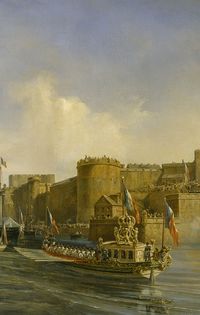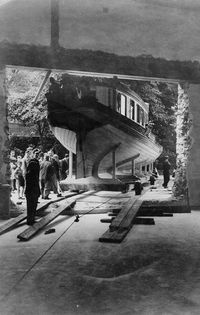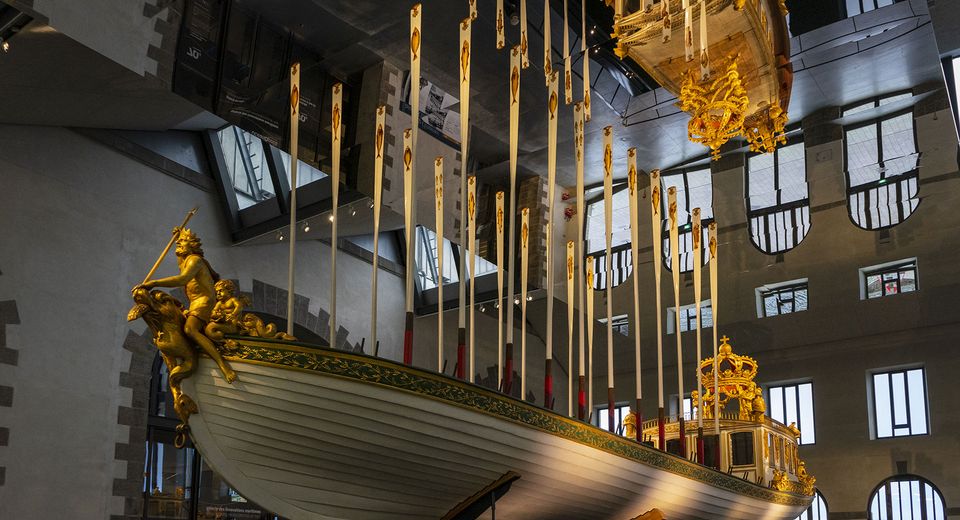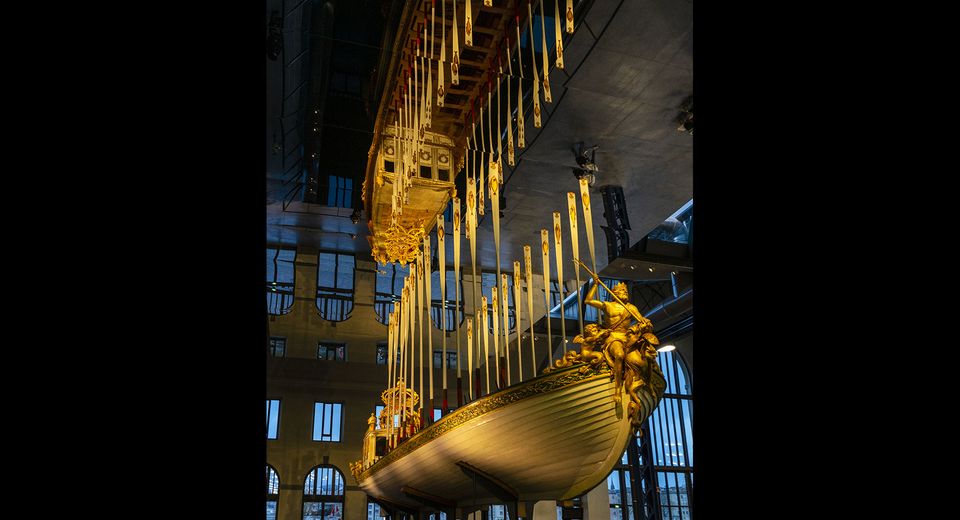The Emperor's canoe
Brest
Among the 40 000 works on exhibition at the musée national de la Marine, the Emperor’s Canoe occupies a place all of its own. Built in 1810, the Canoe remained in Brest from 1814 to 1943 before being moved to Paris. It is the only ceremonial canoe conserved in a French museum. Its arrival in Brest in 2018 at the Ateliers des Capucins marked a return to its home port.
The story of the Emperor’s Canoe
 Enlarge image : Visite de Napoléon III à Brest
Enlarge image : Visite de Napoléon III à Brest
Auguste Mayer (1805-1890) 1859 © Musée national de la Marine/Arnaud Fux
The Canoe’s construction and career
Napoleon I’s Imperial Canoe is the only boat of its kind that France has succeeded in preserving in its entirety.
Its construction was decided on in the greatest secrecy in the spring of 1810, when the Emperor was planning to go to Antwerp to visit the naval shipyard whose creation he had ordered a few years earlier.
The engineer Guillemard provided the canoe’s plans while master shipwright Théau, a native of Granville, oversaw its construction. Its decorative components were entrusted to the Antwerp sculptor Van Petersen. The boat was completed in just 21 days. It is over 18 metres long, its back third dominated by a spacious deckhouse designed to accommodate the dignitaries on board while the rowers occupied the rest of the space. Its initial decoration was somewhat basic.
On 30 April 1810, the Ceremonial Canoe made a grand entrance into Antwerp: Napoleon and the young Empress Marie-Louise were on board, accompanied by Marshal Berthier, the Minister of the Navy Denis Decrès and Admiral Missiessy, commander of the Scheldt Squadron; they were surrounded by a veritable naval cortege. The Emperor made use of the Canoe for several days, as he visited the flagship Le Charlemagne, attended the spectacular launch of the Le Friedland and inspected his entire fleet.
In 1814, the Canoe was sent to Brest. Additions were made to its decoration, which remained relatively simple nonetheless, with an eagle as its figurehead. Further changes were made to its decoration before Napoléon III and Empress Eugenie’s visit to Brest in 1858. Its present sculpted features date from that period, including the figurehead representing Neptune, the group in the stern with the Imperial coat of arms, and the great crown supported by four cherubs that tops the deckhouse.
Even the oars were adorned with lavish painted motifs.
The Canoe’s rescue
 Enlarge image : Entrée du Canot de l’Empereur dans le musée
Enlarge image : Entrée du Canot de l’Empereur dans le musée
All but forgotten, the Emperor’s Canoe might well have met its end under the bombs that destroyed Brest at the end of the Second World War. As fate would have it, though, creation of the Maritime Museum was underway at Palais de Chaillot. Space was no object: The imperial vessel could be its flagship.
The Canoe left Brest on 9 May 1943 under the protection of the German authorities. It crossed Paris on a lorry, giving bystanders something to talk about. The entire operation was controlled, measured and timed, but a problem arose when it finally came to getting the Canoe into the museum: the doors were too narrow! More than two years of negotiations were required in order to find a solution. Finally, in August 1945, a wide breach was made in Palais de Chaillot’s wall and, very gently, the Imperial Canoe was slid into its last resting place after having spent the meantime in the Trocadéro’s gardens.
The Canoe in Brest
The Canoe was restored throughout between 2001 and 2003 by the Cherbourg military shipyard’s shipwrights (the hull’s cradles and internal structure) and a group of restorers (sculptures, polychromy and gilding), with support from the Napoleon Foundation.
In 2018, the Canoe returned to its home port in Brest, to an emblematic site in a city that has become a cultural and economic centre: the Plateau and Ateliers des Capucins.
Collection highlight
The essential works to see during your visit to the Musée national de la Marine in Brest, Port-Louis, Rochefort, Toulon, and soon in Paris.


